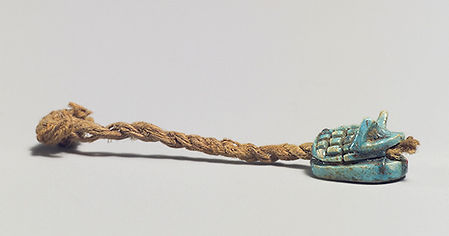
Ancient amulets
In the present, as well as in the past, amulets can be found in a greater variety than can be described here on one page. Magic amulets in the form of beads, writing, color, material; anything out of the ordinary linking to all sorts of 'powers' (sexuality, desirability, the underworld) can be used as amulet. I have selected some items of interest here, commonly used as amulets in Pharaonic Egypt. For instance beaded mummy nets (below right), or strings of amulets wrapped around the arm of a mummy (below left), helping the dead in the afterlife. There are some unique examples of amulets showing how apotropaic elements were used or worn by people. But magic protection could also be gained by applying make-up like kohl or by burying the dead with a supply of kohl make-up or even strands of hair.

Mummy of Djedptahjuefanch, now in the Cairo museum (CG61097). He was the third Prophet of Amun, dated to the reign of king Sheschonq I. The image shows beautifully the way in which amulets were worn on the arm with string.

This lead amulet, was found in Karanis, Egypt and dates to the 3rd or 4th century A.D. It is folded around the string and was probably worn around the wrist or ankle. It has still never been unrolled, so its contents remain unknown.
Hedgehog amulet on a string, Dynasty 12 (ca. 1981–1802 B.C.)
Found in Lisht North, Pit 995
The amulet is made of glazed steatite and reed used for the string. Although never very common, hedgehog amulets have a long history in ancient Egypt, they were especiallt popular in the New Kingdom. For reasons that remain unclear these are rebirth symbols. Maybe these charms protected the deceased because the hedgehog lived in the low desert's harsh environment near cemeteries.

Mummy net in the archaeological museum of Bologna, Italy. These nets aided the deceased in the afterlife. Click here for additional information on mummy nets.

This is a textile bun containing protective materials. An unidentified black organic substance was found in the amulet on the left, possibly medication of some sort. The bundle was kept together by string and a seal. The right amulet contained a mineral. The amulets were found in Lahun and are now kept in London (UC 7502 and 7423). They probably date to the late Middle Kingdom (about 1850-1750 BC).




